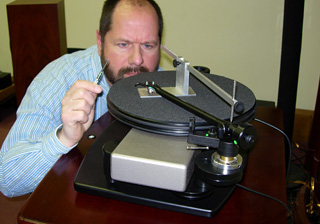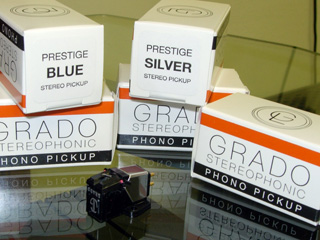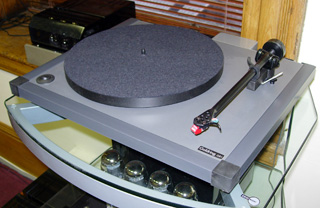![[SoundStage!]](../sslogo3.gif) The Candy Store The Candy StoreBack-Issue Article |
April 2006 Into the Groove[Fade in] A customer listens carefully, all nestled in the soft leather of a European media chair. In front of him sits an audio arrangement carefully selected and set up by yours truly. The customer is relaxed, perhaps sipping on a hot cup of coffee, freshly ground from the bean of his choice. Hey, we run a class joint here. An occasional comment or question is uttered about the piece of music being played or the equipment in use. Everything is sounding very good. You can see the customer beginning to forget about the equipment and really listening to the music. [Cut to the side door at the back of the room] In walks another customer. He leans against the back counter, next to the golden-eared audio consultant (me). In no time at all you can tell that the newcomer is enamored with what he is hearing. His mouth is slightly open. His eyes are closed. His face and body remain frozen except for the slight tapping of his fingers on the counter, keeping the beat of the music. Then it happens. The newcomer leans over (I can see it coming) and politely whispers in my ear. "I’ve been looking for a new CD player. What do I need to spend to get one that sounds like this?" I reply. "Well, you can’t really buy one that sounds like this. It’s not a CD player. It’s a turntable." Bitten What generally follows is a long conversation that begins with the customer expressing shock and disbelief. He never thought records could sound like this. He used to have quite a collection, until he replaced his turntable with a CD player in the '80s. His direct-drive Technics never sounded like this. No, I reply, it probably didn’t. If he’s lucky he still has his LP collection stored somewhere safe. He’s been bitten by the analog bug, and this bug’s bite has a very high rate of infection. I get no greater pleasure from my work than seeing the face of someone who is either rediscovering analog or hearing it for the first time. It’s as though this person has just been let in on some very privileged information, a secret known only to a select few. You see a grin appear, and it stays. This person has just experienced the original high-rez format, which has been sitting around for decades without the agonies of format wars to get in its way. The process When a customer purchases a CD player, he auditions, selects, and buys. For the most part, he is then done with the process. Sure, there may be some tweaking with a cable here and there, or playing with some isolation devices, but for the most part, he’s done. For some customers this is a good thing. They are too busy to muster the dedication that is expected for good analog playback. They prefer the simplicity and convenience that digital playback offers. The analog customer’s process is much more involved; "involved" is a very good word for analog hobbyists. The education process is more intricate. For many customers it is a re-education. For those who last owned a turntable in 1978, there is a lot to learn. In 1978, many dealers were pushing the virtues of direct-drive tables. Horsepower in muscle cars was on its way down, but torque was on the rise with turntables. Would you perform delicate surgery under the hood of a revving 1969 Z-28 Camaro? Connecting a high-torque motor directly to a platter that will interface with a delicate stylus trying to trace the intricate groove on a record is not an audiophile’s dream. Good for DJs, bad for sound. No wonder the CD player was so quickly accepted.
If your dealer doesn’t have someone with the skills to provide a precision analog setup, then you are wasting your money. A misaligned cartridge is akin to taping a sock over the tweeters or replacing that Mark Levinson amp with a Magnavox. Some cartridges and 'arms may be more forgiving than others, but, yes, it’s that critical. Vertical tracking force, vertical tracking angle, azimuth, overhang, anti-skating, and proper cartridge loading are all vital settings for getting the most out of your records. It takes knowledge, experience, and the proper tools to do the job right. If your dealer expects you to do your own setup, you should be looking for another dealer. Our winners
I certainly can’t say that the gear our store carries is the only good stuff out there. In fact, I won’t even lay claim to having the best in every category. There is simply too much great equipment, much of which I haven’t had the chance to audition. I will share a few special items that I recommend to friends as well as customers. For the person out there who has just discovered that old Dual 1226 or Pioneer direct-drive 'table in the back of his closet and wants to get it up and running again, I have the following advice: Find a dealer who carries Grado Prestige cartridges. For under forty bucks, you can have a Prestige Black mounted on that 'table that only recently was collecting dust. Properly set up, this cartridge can really sing and give you a taste of what the fuss is all about. Grado makes several cartridges in this line -- all the way up to the Gold at about $180. Every one of them should be listed as a best buy. (Note: Grado cartridges have been known to hum when used with older Rega 'tables and select others with poorly shielded motors. Check with your dealer on this.)
If you’re ready to move up into the world of the moving-coil analog, there’s no bigger bargain than the Dynavector 10X5 ($385). It’s a high-output design (2.5mV), which means you can use either a moving-magnet or moving-coil phono stage. It loves Rega 'arms and is an especially synergistic match with the Nottingham Horizon 'table. You can spend double the money and not get a more balanced cartridge. One of the biggest upgrades I’ve encountered in my system occurred when I replaced a modded Rega 'arm with an Origin Live Silver 'arm. This is one of those giant-killers. It goes for under a grand and will compete with 'arms costing two to three times its asking price -- and more. Analog is personal The relationship that I develop with my analog customers is very different from that with the digital crowd. It seems stronger and deeper. I have several friends who started off as analog customers (and still are). I think it harkens back to the early days of the hobby, when it still was a hobby. The stories of analog customers are always the best.
Leo listened silently until the music ended. He then shared a story of his youth. Apparently Leo was quite a violinist in his earlier years. He spoke of hours and hours of practice and how he was quite talented in his day. He told of the great day that he played for the King of England. He talked about his cousin who was once a teacher of the great cellist Jacqueline DuPré. Leo’s fingers were no longer able to command a violin, but his passion for music was as strong as ever. It was a big black slab of vinyl that had sparked his emotions and transported him back to a special world. This is what it’s all about. ...Bill Brooks |
|
![[SoundStage!]](../sslogo3.gif) All Contents All ContentsCopyright © 2006 SoundStage! All Rights Reserved |
 Selecting pieces in an analog
setup has its own set of difficulties. You have to find a knowledgeable dealer you really
trust. You are not selecting just one component, but three (or four if you need to add a
phono stage) when you buy a turntable. It’s a lot like choosing an entire audio
system when you select analog gear. The quality of individual components is important, but
how they interact with each other is much more vital. Synergy takes a real jump
with analog. You can spend thousands on a bad match that can be easily beaten by the right
combo that costs only hundreds. It’s not really practical for dealers to allow
customers to take home a variety of cartridge/tonearm combinations to try. A good dealer
will give you a great demo in the store and be able to explain or demonstrate the best
synergistic combinations. They should even allow a home demo when the choice is narrowed
down. But obviously it’s not possible for a dealer to throw a few cartridges and
'arms in a bag and let the customer have at it.
Selecting pieces in an analog
setup has its own set of difficulties. You have to find a knowledgeable dealer you really
trust. You are not selecting just one component, but three (or four if you need to add a
phono stage) when you buy a turntable. It’s a lot like choosing an entire audio
system when you select analog gear. The quality of individual components is important, but
how they interact with each other is much more vital. Synergy takes a real jump
with analog. You can spend thousands on a bad match that can be easily beaten by the right
combo that costs only hundreds. It’s not really practical for dealers to allow
customers to take home a variety of cartridge/tonearm combinations to try. A good dealer
will give you a great demo in the store and be able to explain or demonstrate the best
synergistic combinations. They should even allow a home demo when the choice is narrowed
down. But obviously it’s not possible for a dealer to throw a few cartridges and
'arms in a bag and let the customer have at it. There is no shortage of great
analog gear. On my last trip to CES in January, I saw more analog gear than at any show I
can remember. Rarely did I enter a room that was without at least one turntable set up and
playing. Analog was everywhere. There was even a room using an open-reel tape deck as the
source -- now that’s a devoted analog lover.
There is no shortage of great
analog gear. On my last trip to CES in January, I saw more analog gear than at any show I
can remember. Rarely did I enter a room that was without at least one turntable set up and
playing. Analog was everywhere. There was even a room using an open-reel tape deck as the
source -- now that’s a devoted analog lover.  If you are looking to buy your
first 'table but don’t want to break the bank or are unsure that the analog thing is
really your bag, then check out the Goldring GR-1 ($425). This table makes better music
than anything I’ve heard for under $600. It uses an 'arm that, for the most part, is
an OEM version of the Rega RB250 and comes complete with a Goldring moving-magnet
cartridge.
If you are looking to buy your
first 'table but don’t want to break the bank or are unsure that the analog thing is
really your bag, then check out the Goldring GR-1 ($425). This table makes better music
than anything I’ve heard for under $600. It uses an 'arm that, for the most part, is
an OEM version of the Rega RB250 and comes complete with a Goldring moving-magnet
cartridge. I am reminded of an elderly
gentleman named Leo who came into the store one day. From his looks and the way he carried
himself, I placed his age at about 70. I later found out that he was over 90. He strolled
in one day complete with a wheeled luggage carrier onto which he had strapped his entire
system (save for the speakers). A vintage receiver, Wollensak tape deck, and a '70s-era
turntable (no CD player) were securely bound to his cart. The man was distraught because
his stereo had quit working and music was everything to him. He had a large collection of
classical music that was a great source of joy to himself and other residents in his
retirement village. I soon assessed the problem to be a stylus issue -- his was about a
decade or two past its lifespan. Forty-five minutes later, I had Leo’s rig up and
running complete with a new Grado Blue cartridge. I put on an old London Treasury pressing
of Mendelssohn’s "Fingal’s Cave," and a few seconds into the music I
saw Leo’s face light up. I could tell by looking into his eyes that he was in another
place.
I am reminded of an elderly
gentleman named Leo who came into the store one day. From his looks and the way he carried
himself, I placed his age at about 70. I later found out that he was over 90. He strolled
in one day complete with a wheeled luggage carrier onto which he had strapped his entire
system (save for the speakers). A vintage receiver, Wollensak tape deck, and a '70s-era
turntable (no CD player) were securely bound to his cart. The man was distraught because
his stereo had quit working and music was everything to him. He had a large collection of
classical music that was a great source of joy to himself and other residents in his
retirement village. I soon assessed the problem to be a stylus issue -- his was about a
decade or two past its lifespan. Forty-five minutes later, I had Leo’s rig up and
running complete with a new Grado Blue cartridge. I put on an old London Treasury pressing
of Mendelssohn’s "Fingal’s Cave," and a few seconds into the music I
saw Leo’s face light up. I could tell by looking into his eyes that he was in another
place.